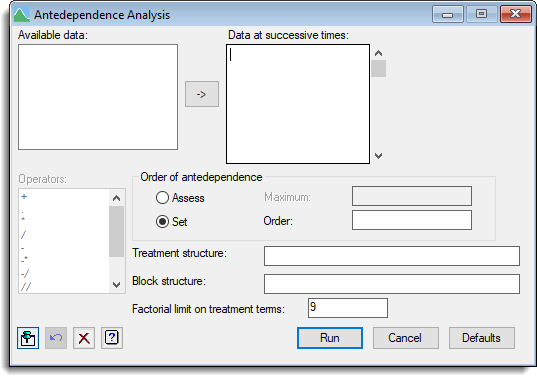Select menu: Stats | Repeated Measurements | Antedependence Analysis
Assesses the order of antedependence for repeated measures data, and calculates overall tests based on a specified order. A repeated-measures design is one in which subjects (animals, people, plots, etc.) are observed several times. Each subject receives a randomly allocated treatment, either at the outset, or repeatedly through the experiment. The subjects are observed at successive occasions to see how the treatment effects develop.
- After you have imported your data, from the menu select
Stats | Repeated Measurements | Antedependence Analysis. - Fill in the fields as required then click Run.

Available data
This lists data structures appropriate to the current input field. It lists either factors for use in specifying the treatment and block structure, or variates for specifying the data and additional covariates. The contents of this field will change as you move from one field to the next. You can double-click a name to copy it to the current input field.
Data at successive times
Used to enter the names of the variates, one for each time point, containing the data observations which are to be analysed. The ![]() button lets you move selections from Available data.
button lets you move selections from Available data.
Order of antedependence
Select Assess to assess the order of ante-dependence. Maximum lets you specify the maximum order against which to test. Select Set to calculate overall tests based on a specific order. Order lets you specify the number of past times for which to adjust.
Treatment structure
Specify the treatment terms to be fitted by entering a model formula.
Block structure
Enter a model formula to define the underlying structure of the design.
Operators
This provides a quick way of entering operators in the treatment and block model formulas. Double-click the required symbol to copy it to the current input field. You can also type in operators directly. See model formula for a description of each.
Factorial limit on treatment terms
Controls the factorial limit for treatment terms when you use model formula operators like *. The default is to include all interactions, up to those involving nine factors. (You cannot use more than nine.)
Action Icons
| Pin | Controls whether to keep the dialog open when you click Run. When the pin is down |
|
| Restore | Restore names into edit fields and default settings. | |
| Clear | Clear all fields and list boxes. | |
| Help | Open the Help topic for this dialog. |